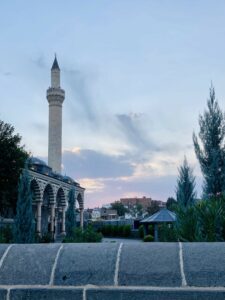After visiting the Safranbolu, the next UNESCO Heritage city on our list was Bam in Iran. However, because of the protests taking place in Iran after the death of Mahsa Amini as well as the limited internet access that followed, we decided to change our plans and skip visiting Iran. Nevertheless, instead of Iran we then unexpectedly visited the Kurdish region of Iraq and also travelled to Saudi Arabia sooner than planned and have already visited quite a few new UNESCO Heritage sites.

Even before leaving Turkey, we managed to see two new Heritage sites, Göreme National Park and the Rock Sites of Cappadocia and Diyarbakır Fortress.
We’ve wanted to go to Cappadocia for some time but were afraid of the high prices and crowds of tourists during this peak travel season. The Capadoccia region actually has 7 different valleys easily accessible by foot. Because most tourists come for just a few days and drive only to the main sights, they are completely empty and more beautiful than you can imagine (photos or videos really can’t capture the extraordinary nature). The fairy chimneys or phalluses, as some describe them, were made by wind and water erosion and the holes and caves were built during the Roman times for living, storage and churches. All in all, we had a great time and were surprised by how beautiful and tranquil nature is, and how few people explore the region behind the museum and the air balloons.

In Diyarbakir, we took part in a Youth Exchange about Islamophobia for 10 days, together with peers from Jordan, Egypt, Turkey, Greece and Bulgaria. It was a great experience exploring this historical city! It is the “capital” of Kurds in Turkey, with a conflicting past. The last clashes in 2016 left the old city centre, including much of the UNESCO-protected fortress destroyed, but it’s rapidly coming back up again. The site includes the 5.8 km-long city walls of Diyarbakir with their various towers, gates, buttresses, and 63 inscriptions, as well as the Inner fortress, also known as çkale and featuring the Amida Mound. It is really magical to sip tea and watch the people strolling and the children playing as the golden light illuminates the fortress and the city walls which are supposed to be the longest complete defensive walls in the world after the Great Wall of China.


Leaving the beloved country that is Turkey, we made our way across the border with Iraq, to the northern Kurdish region of the country. Our first stop was Erbil, the biggest city in the region, where we met some new friends who took us to an opera concert in the old citadel, organised by the Czech consulate there. Located in the historical city centre of Erbil, on a hill overlooking the always lively main square and the enchanting old Bazaar, it was a magical thing to experience on our first evening in the city. The 5th millennium BC is the first indication of human settlement in the area around the citadel. The citadel’s original fortifications were eventually replaced with homes, but the continuous wall of tall 19th-century house façades still gives the appearance that an unassailable stronghold dominates the city.

From Iraq, our journey continues to Saudi Arabia, more specifically, its Eastern province, which is home to the biggest oasis in the world, the Al-Ahsa Oasis. The oasis is an important area in terms of its unique nature and geography, historically and economically. It is actually home to the largest conventional oil field in the world, the Ghawar Field and with 2.5 million palm trees it is also responsible for a large amount of Saudi date production, with the country being the second largest date producer in the world. The mix of oil production facilities and neverending palm forests is truly a unique sight.

Economics aside, the oasis presents evidence of human settlement in the Gulf region from the Neolithic until today. It possesses unique historical evidence of the continued human habitation in the area with the unique construction of fortresses, mosques, wells, and a network of open-air canals, which show a unique way of distributing water through the centuries. The historical buildings somehow act in harmony with a truly outlandish-looking geography of huge orange rocks scattered around the desert landscape. We were even lucky enough to join a tour to a hard-to-reach Al-Asfar lake, which is surrounded by sand dunes and nothing like we’ve ever seen before.

Changing our plans and leaving Iran out was a hard decision to make. Nevertheless, it’s definitely a country we plan on visiting when the situation allows it. Taking everything into account, our spontaneous adventures in Iraq and additional time in Saudi was an opportunity that we otherwise wouldn’t have and the Heritage sights that we saw before on during this time are memories that will undoubtedly not be forgotten.
